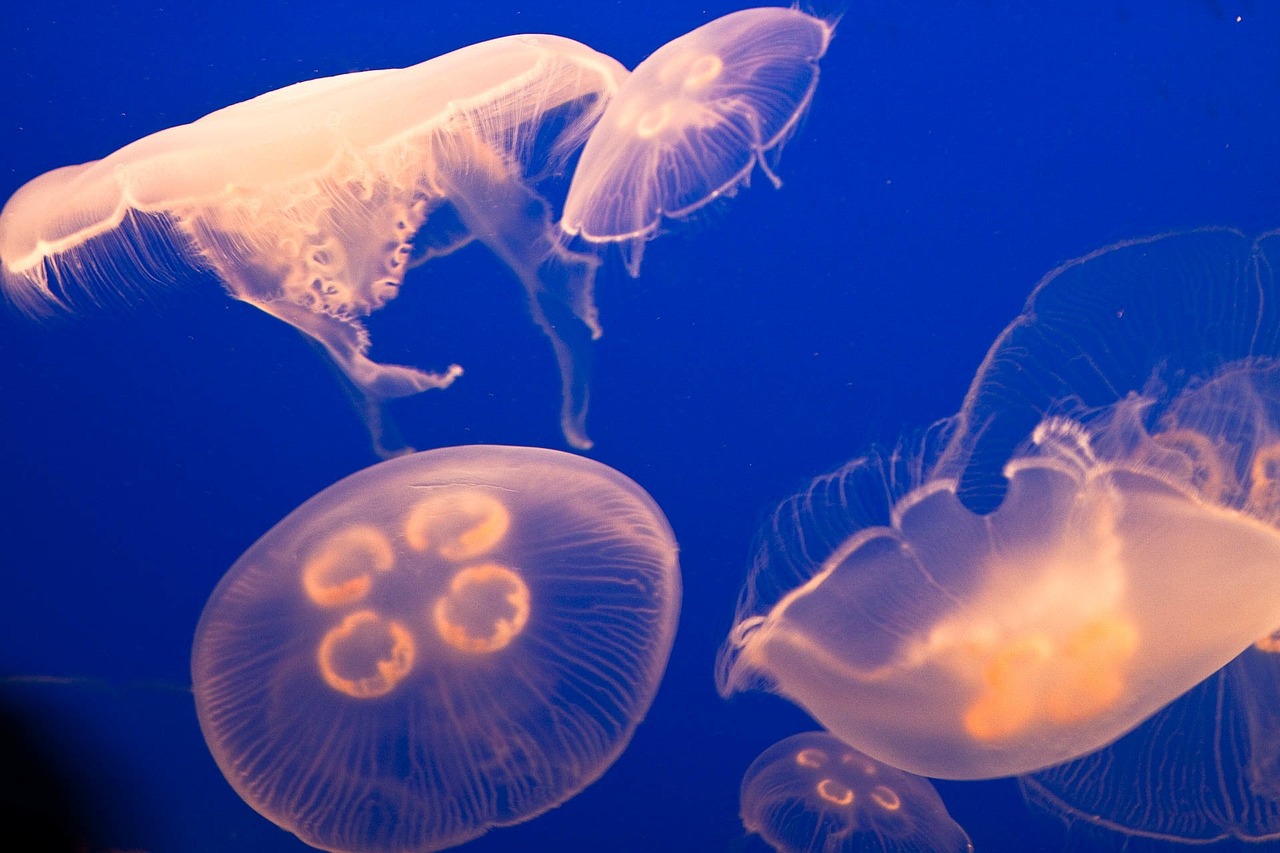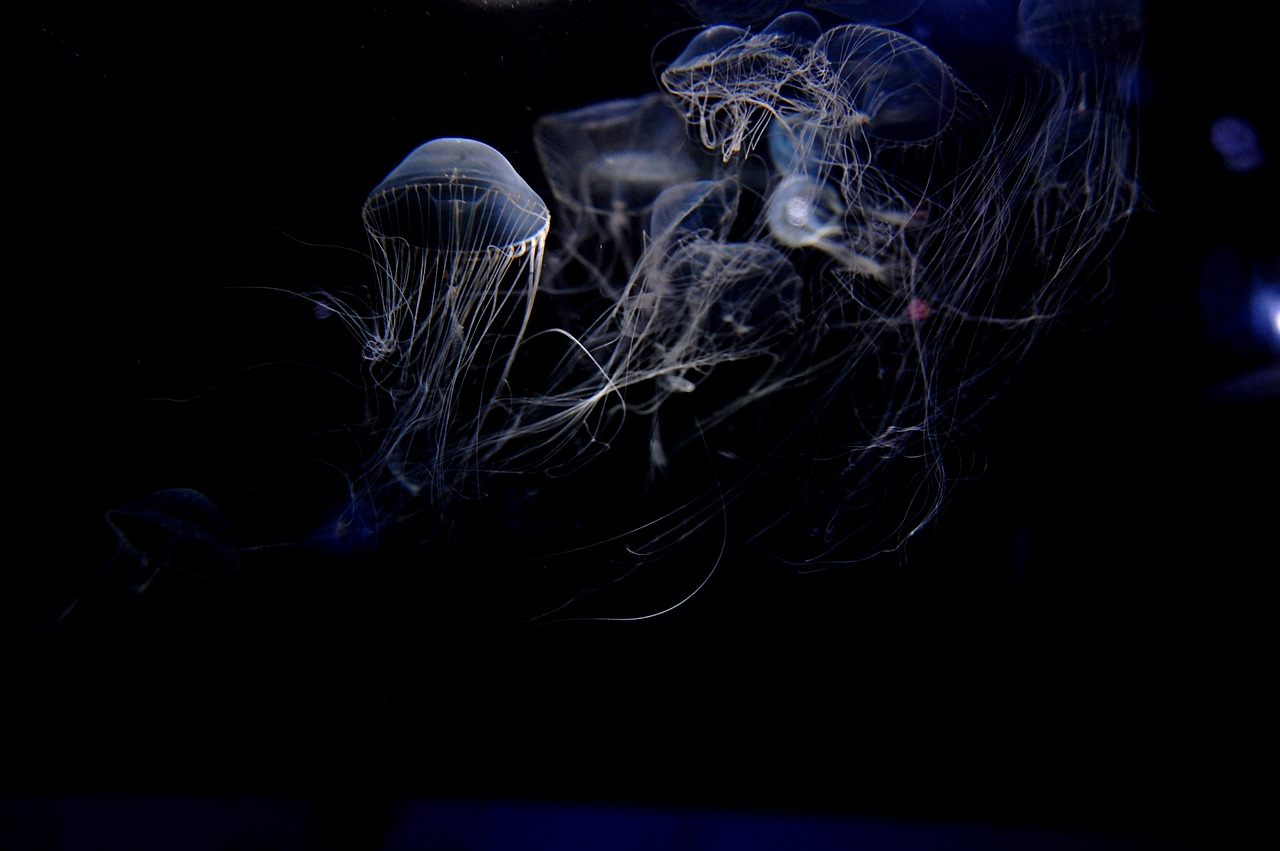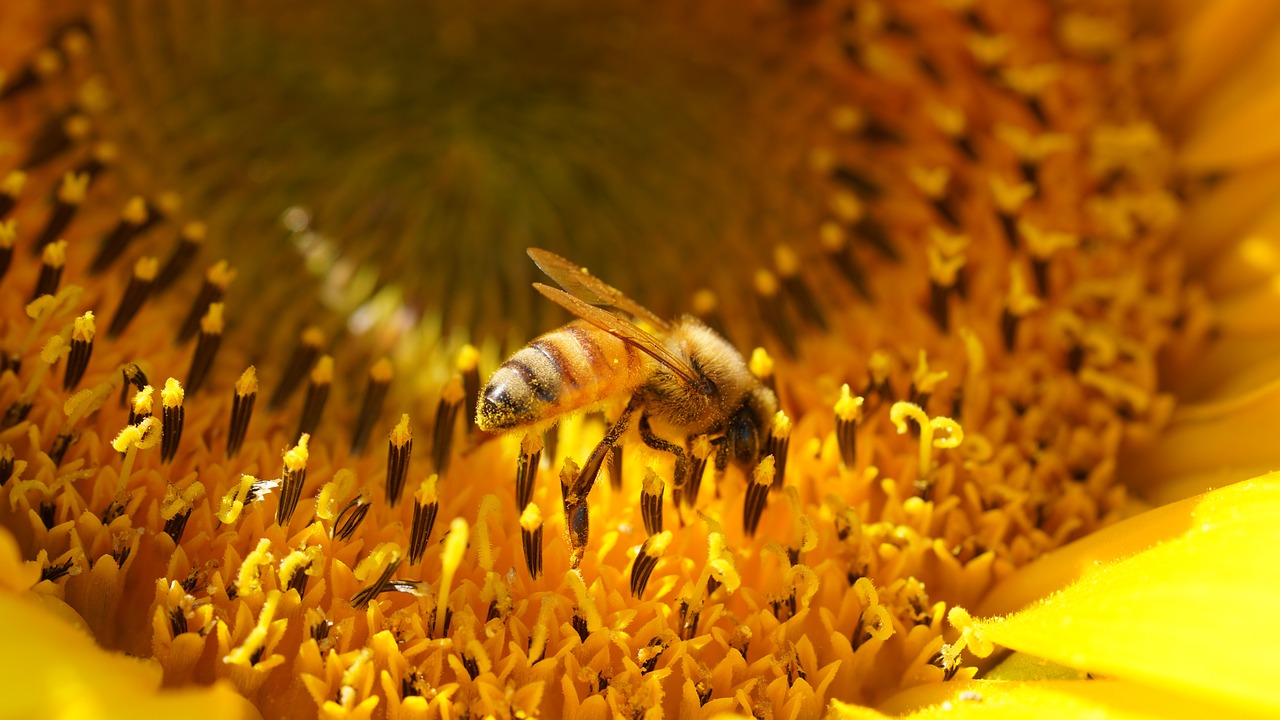Delving into the Depths: Exploring the Biodiversity of Deep Seas
The deep sea is one of the most enigmatic and unexplored regions on our planet, teeming with incredible biodiversity that remains largely a mystery to humanity. As we plunge into these dark, cold waters, we encounter a world that is not just alien but also vital to the health of our oceans and the planet as a whole. The deep sea is home to a myriad of unique species, each adapted to survive in extreme conditions, showcasing the wonders of evolution. Imagine the thrill of discovering a creature that glows in the dark or one that can withstand pressure that would crush a submarine! This article aims to unravel the secrets of deep sea biodiversity, highlighting its significance, the unique adaptations of its inhabitants, and the threats it faces.
Understanding deep sea biodiversity is not merely an academic pursuit; it is crucial for maintaining the health of our oceans and, by extension, the entire planet. These underwater ecosystems play a pivotal role in regulating global climate, influencing weather patterns, and supporting marine food webs. The deep sea acts as a carbon sink, absorbing carbon dioxide from the atmosphere, which helps mitigate climate change. Furthermore, the unique species residing in these depths contribute to the overall ecological balance of marine environments. Protecting these ecosystems is essential, not just for the organisms that inhabit them, but for the health of our planet.
The deep sea is a treasure trove of unique species, many of which have evolved astonishing adaptations to thrive in their extreme environment. From the mesmerizing bioluminescent creatures that light up the darkness to the elusive giant squid, the diversity of life forms is staggering. These organisms have developed remarkable traits that allow them to hunt, evade predators, and reproduce in conditions that would be inhospitable to most life forms. For instance, the anglerfish uses a bioluminescent lure to attract prey, while the giant squid can jet away from threats with incredible speed. Each of these adaptations is a testament to the resilience of life and the intricate web of interactions that define deep-sea ecosystems.
One of the most fascinating phenomena of deep sea life is bioluminescence. This natural light show serves various purposes, such as attracting mates, luring prey, and deterring predators. Imagine being in a pitch-black environment and seeing a flash of blue or green light; it’s like nature’s very own disco! Bioluminescence is not just for show; it highlights the complex interactions among deep-sea organisms, contributing to their survival in a world devoid of sunlight.
The science behind bioluminescence is equally captivating. It occurs through chemical reactions involving substances known as luciferin and luciferase. When these chemicals react, they produce light, a process that varies among different species. Understanding these mechanisms provides insights into evolutionary adaptations and ecological roles. For example, some species use bioluminescence as a defense mechanism, creating a sudden burst of light to confuse predators and make their escape.
Among the myriad of bioluminescent species, two stand out for their remarkable adaptations:
- Anglerfish: Known for its unique lure, the anglerfish attracts prey with a glowing appendage that dangles in front of its mouth.
- Jellyfish: Certain jellyfish exhibit stunning bioluminescent displays, creating a beautiful spectacle as they pulse through the water.
Life in the deep sea is not for the faint-hearted. Organisms here have evolved extraordinary adaptations to survive in environments characterized by extreme pressure, darkness, and frigid temperatures. For instance, many deep-sea fish have flexible bodies that can withstand crushing depths, while others possess specialized enzymes that function optimally in cold conditions. These adaptations not only showcase the resilience of life but also highlight the intricate balance of deep-sea ecosystems.
Despite the wonders of deep sea biodiversity, these ecosystems face numerous threats that jeopardize their delicate balance. Climate change, deep-sea mining, and overfishing are significant concerns that can lead to irreversible damage. As we continue to explore and exploit these underwater realms, it is crucial to recognize the impact of our actions on these fragile habitats.
Rising ocean temperatures and acidification pose significant risks to deep-sea biodiversity. These changes can affect species distribution, reproductive patterns, and overall ecosystem health. For instance, as temperatures rise, some species may be forced to migrate to cooler waters, disrupting established food webs. The urgency for conservation efforts has never been greater, as the clock ticks down on the health of our oceans.
The push for deep-sea mining for minerals threatens fragile ecosystems. The extraction process can lead to sediment plumes that smother marine life and disrupt habitats. This highlights the need for sustainable practices and regulations that protect these unique ecosystems from irreversible damage.
Efforts to conserve deep sea biodiversity are gaining momentum, with initiatives aimed at establishing marine protected areas and promoting sustainable practices. These efforts emphasize the importance of preserving these unique ecosystems for future generations, ensuring that the wonders of the deep sea are not lost to human activity.
Creating marine protected areas can help safeguard critical habitats and species. These zones allow ecosystems to recover and thrive while providing valuable research opportunities for scientists. By protecting these areas, we can ensure the survival of countless species and the health of our oceans.
Engaging local communities and stakeholders in conservation initiatives fosters a sense of stewardship. When people understand the importance of deep-sea ecosystems, they are more likely to support efforts to protect them. Collective efforts and sustainable practices can make a significant difference in preserving these underwater realms.
- What is deep sea biodiversity? Deep sea biodiversity refers to the variety of life forms found in the deep ocean, including unique species that have adapted to extreme conditions.
- Why is deep sea biodiversity important? It plays a critical role in maintaining ocean health, influencing global climate, and supporting marine food webs.
- What are some threats to deep sea biodiversity? Major threats include climate change, deep-sea mining, and overfishing, all of which can disrupt these fragile ecosystems.
- How can we protect deep sea biodiversity? Conservation efforts like establishing marine protected areas and engaging local communities are essential for safeguarding these ecosystems.

The Importance of Deep Sea Biodiversity
Deep sea biodiversity is not just a fascinating subject for marine biologists; it plays a critical role in maintaining the overall health of our oceans. Think of the deep sea as a hidden treasure chest, filled with unique species that contribute to the intricate web of life beneath the waves. These ecosystems are essential for various reasons, including their influence on global climate and the support they provide to marine food webs. Understanding and protecting these unique ecosystems is crucial for the sustainability of our planet.
One of the most significant aspects of deep sea biodiversity is its ability to regulate climate. The ocean, particularly the deep sea, acts as a massive carbon sink, absorbing carbon dioxide from the atmosphere. This process helps mitigate climate change and maintain the balance of atmospheric gases. Moreover, the deep sea is home to organisms that play a vital role in nutrient cycling, which is essential for the health of marine ecosystems. The interactions between these organisms create a complex network that supports life at all levels of the ocean.
Furthermore, the deep sea is a reservoir of genetic diversity. Many species found in these depths have unique adaptations that allow them to thrive in extreme conditions. This genetic diversity is not just fascinating from a biological standpoint; it has practical applications as well. For instance, compounds derived from deep-sea organisms are being researched for their potential in medicine and biotechnology. By preserving these ecosystems, we safeguard a wealth of genetic resources that could lead to groundbreaking discoveries in various fields.
The ecological significance of deep sea biodiversity extends to the marine food web. Many fish and marine mammals rely on deep-sea organisms as a primary food source. The loss of biodiversity in these ecosystems can lead to cascading effects throughout the marine food web, impacting species at all levels. For example, if a key species were to decline, it could disrupt the entire ecosystem, leading to a reduction in fish populations and affecting human communities that rely on fishing for their livelihoods.
In essence, the importance of deep sea biodiversity cannot be overstated. It is a complex and dynamic system that supports life, regulates our climate, and holds potential for future scientific advancements. Protecting these underwater realms is not just about conserving marine life; it is about ensuring a healthy planet for future generations. As we delve deeper into the mysteries of the ocean, we must remember that every species, no matter how small, plays a vital role in the grand tapestry of life.
- Why is deep sea biodiversity important? It plays a critical role in maintaining ocean health, regulating climate, and supporting marine food webs.
- What threats do deep sea ecosystems face? Climate change, deep-sea mining, and overfishing are significant threats to deep sea biodiversity.
- How can we protect deep sea biodiversity? Establishing marine protected areas and promoting sustainable practices are essential steps in conservation.
- What are some unique species found in the deep sea? Species like the anglerfish and certain jellyfish are known for their stunning adaptations, including bioluminescence.

Unique Species of the Deep Sea
The deep sea is one of the most enigmatic and unexplored realms on our planet, teeming with a plethora of unique species that have adapted to survive in conditions that would be utterly inhospitable to most life forms. Imagine navigating through an environment where sunlight barely penetrates, temperatures hover near freezing, and pressures are immense—this is the everyday reality for deep-sea creatures. Their adaptations are nothing short of astonishing, showcasing the wonders of evolution and the resilience of life.
Among the myriad of species found in these dark depths, some stand out due to their extraordinary features and behaviors. For instance, the anglerfish is famous for its bioluminescent lure, which dangles from its head to attract unsuspecting prey in the pitch-black waters. This fascinating adaptation not only highlights the ingenuity of nature but also illustrates the fierce competition for survival in the deep sea. Similarly, the giant squid, often shrouded in mystery, can grow up to 43 feet long and possesses specialized eyes that allow it to detect the faintest light in the dark ocean. These adaptations are crucial for hunting and evading predators.
One of the most intriguing aspects of deep-sea biodiversity is bioluminescence. This phenomenon is not just a spectacle; it serves multiple essential functions. For example, many deep-sea organisms use bioluminescence to:
- Attract mates: Some species emit light patterns to signal potential partners.
- Lure prey: Creatures like the anglerfish utilize their glowing appendages to entice smaller fish.
- Defend against predators: Certain species can produce sudden bursts of light to confuse or deter threats.
Understanding these unique species and their adaptations is crucial not just for scientific curiosity, but also for appreciating the ecological roles they play. For instance, the deep-sea ecosystem relies heavily on these organisms for nutrient cycling, as many of them are key players in the food web. The presence of such diverse life forms also indicates the health of the oceanic environment, making their conservation vital.
As we dive deeper into this mysterious world, it's essential to recognize that many of these species are still undiscovered. Recent explorations have revealed new life forms, each with unique traits that contribute to the overall biodiversity of the deep sea. The ongoing research in this field is not only exciting but also critical for understanding how these ecosystems function and how they can be preserved for future generations.
In conclusion, the unique species of the deep sea are a testament to nature's creativity and adaptability. From the mesmerizing glow of bioluminescent creatures to the sheer size of the giant squid, these organisms remind us that life can thrive in the most unexpected places. As we continue to explore and learn about these incredible beings, we must also commit to protecting their habitats, ensuring that the deep sea remains a vibrant and essential part of our planet's biodiversity.

Bioluminescence: Nature's Light Show
Imagine diving into the depths of the ocean, where the sunlight barely penetrates, and the world is cloaked in darkness. In this eerie yet mesmerizing environment, a magical phenomenon occurs—bioluminescence. This natural light show is not just a spectacle; it serves crucial purposes for the organisms that inhabit these depths. From attracting mates to luring unsuspecting prey and warding off predators, bioluminescence is a testament to the incredible adaptations of deep-sea life.
Bioluminescence is produced through a series of chemical reactions within the organisms, typically involving substances known as luciferin and luciferase. When these two compounds interact, they emit light, creating a glow that can vary in color, intensity, and duration. The exact mechanisms can differ from one species to another, but the underlying chemistry remains a fascinating area of study. Understanding how these organisms produce light not only sheds light on their evolutionary adaptations but also reveals the intricate ecological roles they play within their habitats.
Take, for example, the anglerfish, a master of disguise and deception. This remarkable creature possesses a bioluminescent lure that dangles from its head, mimicking the appearance of prey. When smaller fish approach, attracted by the enchanting glow, they find themselves in a deadly game of cat and mouse. Similarly, certain species of jellyfish utilize bioluminescence to create stunning displays that can bewilder predators and potential threats, allowing them to escape unharmed.
But the wonders of bioluminescence don't stop there. Many deep-sea organisms, such as the firefly squid and the cookiecutter shark, exhibit unique light patterns that serve as communication signals or camouflage against the ocean's dark backdrop. It's almost as if the deep sea is a grand theater, with each species performing its own act in a never-ending play of survival.
In summary, bioluminescence is a captivating aspect of deep-sea ecosystems, showcasing the evolutionary ingenuity of life in extreme environments. As we continue to explore these mysterious depths, we uncover not only the beauty of bioluminescent organisms but also the complex interactions that sustain the rich biodiversity of our oceans.
- What is bioluminescence? Bioluminescence is the natural ability of certain organisms to produce light through chemical reactions within their bodies.
- Why do deep-sea creatures use bioluminescence? Deep-sea creatures use bioluminescence for various purposes, including attracting mates, luring prey, and deterring predators.
- Can all deep-sea creatures produce light? No, not all deep-sea creatures can produce light; it is a specific adaptation found in certain species.
- How is bioluminescence produced? Bioluminescence is typically produced through the reaction of luciferin and luciferase, resulting in a glow.

Mechanisms of Bioluminescence
Bioluminescence is one of nature's most captivating phenomena, found in a variety of organisms residing in the deep sea. This enchanting glow is produced through a series of complex chemical reactions that occur within the cells of these organisms. At the heart of this process are two key components: luciferin and luciferase. Luciferen is a light-emitting molecule, while luciferase is the enzyme that catalyzes the reaction, leading to the emission of light. The interaction between these two components varies across species, resulting in a dazzling array of colors and intensities.
To better understand this intricate mechanism, let’s break it down into a few fundamental steps:
- Activation: The process begins when luciferin is oxidized, typically in the presence of oxygen.
- Enzymatic Reaction: The luciferase enzyme facilitates the reaction, stabilizing the intermediate compounds formed during the oxidation.
- Light Emission: As the reaction proceeds, energy is released in the form of light, creating the stunning bioluminescent display.
This bioluminescent light can serve various purposes within the deep-sea ecosystem. For instance, some species utilize it for communication, while others use it for camouflage or to attract prey. The adaptability of bioluminescence is a testament to the evolutionary ingenuity of these organisms, allowing them to thrive in one of the most extreme environments on Earth. Understanding the mechanisms behind bioluminescence not only fascinates scientists but also opens doors to potential applications in medicine and technology.
Q: What is bioluminescence?
A: Bioluminescence is the natural phenomenon where living organisms produce light through chemical reactions within their bodies, often for purposes such as attracting mates or luring prey.
Q: Which organisms exhibit bioluminescence?
A: Many deep-sea creatures, including certain species of jellyfish, anglerfish, and some types of plankton, are known for their bioluminescent capabilities.
Q: How does bioluminescence benefit deep-sea organisms?
A: Bioluminescence serves multiple functions, including communication, camouflage, and predation, which are crucial for survival in the dark depths of the ocean.
Q: Can bioluminescence be replicated in laboratory settings?
A: Yes, researchers have been able to replicate bioluminescent reactions in controlled environments, leading to advancements in various fields, including medical research and environmental monitoring.

Examples of Bioluminescent Species
The deep sea is a treasure trove of bioluminescent species, each showcasing nature's incredible ability to adapt and survive in one of the most extreme environments on Earth. Among these fascinating creatures, we can find the mesmerizing anglerfish, which uses a bioluminescent lure to attract unsuspecting prey in the pitch-black depths. This eerie light, emanating from a specialized organ on its head, serves as a beacon in the dark, demonstrating the delicate balance of predator and prey in these underwater realms.
Another captivating example is the jellyfish, particularly species like the Aequorea victoria, known for its stunning green glow. These jellyfish not only illuminate their surroundings but also play a crucial role in the marine ecosystem, serving as both prey and predator. Their bioluminescence can confuse potential threats, allowing them to escape from predators. This characteristic highlights the evolutionary advantages that bioluminescence provides in the deep sea.
Additionally, the firefly squid, found in the waters of Japan, is another remarkable example. These tiny squids exhibit a dazzling light show during their mating rituals, creating a spectacle that draws both mates and human admirers alike. Their ability to produce light in various patterns not only enhances their reproductive success but also showcases the intricate social behaviors of deep-sea organisms.
Here’s a quick look at some notable bioluminescent species:
| Species | Habitat | Bioluminescent Feature |
|---|---|---|
| Anglerfish | Deep Sea | Luminous lure for attracting prey |
| Aequorea victoria (Jellyfish) | Coastal Waters | Green glow for defense and communication |
| Firefly Squid | Japanese Waters | Light displays during mating rituals |
These examples illustrate just a fraction of the diversity found in the bioluminescent world of the deep sea. Each species has developed unique adaptations that allow them to thrive in their specific habitats, highlighting the incredible complexity and interdependence of life beneath the waves. As we continue to explore these dark depths, who knows what other astonishing forms of life await discovery? The deep sea not only fascinates us but also reminds us of the importance of preserving these ecosystems for future generations.
- What is bioluminescence?
Bioluminescence is the natural phenomenon where living organisms produce light through biochemical reactions, often for communication, camouflage, or attracting prey.
- Why is deep sea biodiversity important?
Deep sea biodiversity is crucial for maintaining ocean health, influencing climate regulation, and supporting marine food webs.
- What are the threats to deep sea ecosystems?
Deep sea ecosystems face threats from climate change, deep-sea mining, and overfishing, which can disrupt the delicate balance of these habitats.
- How can we protect deep sea biodiversity?
Conservation efforts such as establishing marine protected areas and engaging local communities in sustainable practices are essential for protecting these unique ecosystems.

Adaptations to Extreme Environments
The deep sea is a realm of extremes, where the pressure can reach over 1,000 times that of the surface, temperatures hover near freezing, and sunlight is but a distant memory. In this unforgiving environment, life has not only persisted but has also evolved some truly remarkable adaptations. Imagine living in a world where darkness is absolute, and the air pressure feels like an elephant sitting on your chest! This is the reality for deep-sea organisms, and they have developed unique traits that allow them to thrive under such conditions.
One of the most fascinating adaptations is the ability of many deep-sea creatures to withstand immense pressure. For instance, the structure of their cell membranes and proteins has evolved to remain stable and functional even at depths where a human would be crushed. Some species, like the Giant Squid, have flexible bodies that can change shape, allowing them to navigate through tight spaces and evade predators.
Moreover, the complete absence of light in the deep sea has led to some incredible adaptations in sensory perception. Many organisms have developed enhanced tactile and chemical senses, enabling them to detect prey and communicate with one another in the dark. For example, the Viperfish utilizes its long, needle-like teeth and sensitive lateral line system to sense movements in the water, making it an efficient predator in the pitch-black depths.
In addition to these physical adaptations, some deep-sea creatures have developed fascinating survival strategies. The Anglerfish, for instance, has a bioluminescent lure that dangles from its head, attracting unsuspecting prey in the darkness. This adaptation not only highlights the creativity of nature but also emphasizes the intricate food webs that exist in these deep-sea ecosystems.
Furthermore, many deep-sea organisms exhibit unique reproductive strategies to ensure the survival of their species. Some species, like the Deep-Sea Lanternfish, engage in mass spawning events, releasing their eggs and sperm into the water simultaneously to increase the chances of fertilization. Others, like the Gulper Eel, have developed the ability to consume prey much larger than themselves, ensuring they can capitalize on the scarce food resources available in their environment.
In summary, the adaptations of deep-sea organisms are a testament to the resilience and ingenuity of life. From extreme pressure tolerance to unique reproductive strategies, these adaptations not only help these creatures survive but also play a vital role in maintaining the ecological balance of the deep sea. As we continue to explore these mysterious depths, we uncover more about the incredible life forms that call the deep sea home and the adaptations that make their existence possible.
- What are some examples of deep-sea adaptations?
Examples include bioluminescence in anglerfish, pressure tolerance in giant squids, and enhanced sensory perception in viperfish. - How do deep-sea organisms reproduce?
Many deep-sea organisms engage in mass spawning events or have unique reproductive strategies to ensure the survival of their species. - Why is deep-sea biodiversity important?
Deep-sea biodiversity is crucial for maintaining ocean health, influencing global climate, and supporting marine food webs.

Threats to Deep Sea Biodiversity
Deep sea ecosystems are some of the most mysterious and unexplored regions on our planet, yet they are facing a multitude of threats that jeopardize their delicate balance. Among these threats, climate change, deep-sea mining, and overfishing stand out as critical challenges that demand our immediate attention. These factors not only endanger the unique species that inhabit these depths but also disrupt the intricate ecological web that supports life in the oceans.
One of the most pressing issues is climate change. As global temperatures rise, ocean temperatures follow suit, leading to a cascade of effects that ripple through deep sea ecosystems. Warmer waters can alter species distributions, pushing some organisms into deeper, cooler waters while forcing others to adapt or face extinction. Additionally, the increasing levels of carbon dioxide in the atmosphere result in ocean acidification, which compromises the ability of marine organisms, such as corals and shellfish, to build their calcium carbonate structures. This not only affects individual species but also the broader marine food web, which relies on these foundational species for survival.
Deep-sea mining is another significant threat that looms large over these underwater realms. As the demand for minerals and resources escalates, companies are increasingly turning to the ocean floor for extraction. This practice involves disturbing fragile habitats and can lead to irreversible damage. The process disrupts sediment layers, which can smother organisms living on the seafloor and release toxic substances that further threaten marine life. The potential for biodiversity loss is staggering, as many deep-sea species are endemic and cannot be found anywhere else on Earth.
Furthermore, overfishing poses a critical risk. As we deplete fish stocks in shallower waters, the fishing industry has begun to target deeper waters, often using destructive methods that catch not only the intended species but also non-target species. This practice not only reduces fish populations but also disrupts the balance of the ecosystem. The removal of key species can lead to a domino effect, causing population booms in other organisms and further destabilizing the ecosystem.
To illustrate the impact of these threats, consider the following table that summarizes the main threats to deep sea biodiversity and their potential consequences:
| Threat | Potential Consequences |
|---|---|
| Climate Change |
|
| Deep-Sea Mining |
|
| Overfishing |
|
In conclusion, the threats to deep sea biodiversity are complex and interrelated, requiring a multifaceted approach to conservation and management. As stewards of the planet, it is our responsibility to recognize these challenges and advocate for sustainable practices that protect these vital ecosystems. The deep sea may be out of sight, but its health is crucial for the overall well-being of our planet.
What are the main threats to deep sea biodiversity?
The main threats include climate change, deep-sea mining, and overfishing, each of which poses significant risks to the delicate ecosystems of the deep sea.
How does climate change affect deep sea species?
Climate change leads to rising ocean temperatures and acidification, which can alter species distributions, reproductive patterns, and overall ecosystem health.
What is deep-sea mining and why is it a concern?
Deep-sea mining involves extracting minerals from the ocean floor, which can cause habitat destruction and the loss of unique species that are not found anywhere else.
Why is overfishing a problem in deep sea ecosystems?
Overfishing reduces fish populations and disrupts the balance of marine ecosystems, leading to further instability and potential extinction of vulnerable species.

Impact of Climate Change
The deep sea, often viewed as a remote and untouched environment, is not immune to the effects of climate change. In fact, rising ocean temperatures and increased acidification are reshaping the very fabric of these dark, mysterious ecosystems. As the planet warms, the deep sea is experiencing shifts in its delicate balance, affecting species distribution and altering reproductive patterns. This is not just a minor inconvenience; it’s a significant threat to the biodiversity that has evolved over millions of years.
Let's break it down a bit. When ocean temperatures rise, many marine species are forced to migrate to cooler waters. This shift can lead to a mismatch in predator-prey relationships and disrupt food webs that have been stable for eons. For instance, if a species of fish moves to deeper, cooler waters, their predators may not follow, leading to a potential collapse of local populations. Moreover, many deep-sea organisms have adapted to specific temperature ranges, and even slight changes can be detrimental to their survival.
Furthermore, ocean acidification—resulting from increased carbon dioxide absorption—poses a severe threat to calcifying organisms such as corals and certain shellfish. These species are vital for maintaining the structural integrity of deep-sea habitats. As the pH of the ocean decreases, their ability to build and maintain their calcium carbonate structures diminishes, leading to habitat loss for countless marine species. This is akin to a house losing its foundation; without it, everything built upon it begins to crumble.
In addition to these direct impacts, climate change can exacerbate existing threats such as overfishing and habitat destruction. For example, as fish populations decline due to overfishing, the remaining species may struggle to adapt to the changing conditions, leading to a cascading effect throughout the ecosystem. This interconnectedness highlights the urgent need for comprehensive conservation strategies that address both climate change and other anthropogenic pressures.
To illustrate the potential impacts of climate change on deep-sea biodiversity, consider the following table:
| Impact of Climate Change | Examples | Consequences |
|---|---|---|
| Rising Ocean Temperatures | Species migration | Disrupted food webs |
| Ocean Acidification | Coral bleaching | Habitat loss |
| Increased Storm Intensity | Habitat destruction | Species extinction |
In conclusion, the impact of climate change on deep-sea biodiversity is profound and multifaceted. It’s not just an environmental issue; it’s a matter of survival for countless species that play critical roles in maintaining ocean health. As we continue to learn more about these underwater worlds, it becomes increasingly clear that we must act swiftly to mitigate the effects of climate change and protect the rich biodiversity that resides in the depths of our oceans.
- What are the main threats to deep-sea biodiversity? The primary threats include climate change, deep-sea mining, and overfishing.
- How does climate change affect deep-sea organisms? It causes shifts in species distribution, alters reproductive patterns, and increases ocean acidification, impacting overall ecosystem health.
- What can be done to protect deep-sea ecosystems? Establishing marine protected areas, promoting sustainable fishing practices, and increasing public awareness are crucial steps.
- Why is deep-sea biodiversity important? It plays a critical role in maintaining ocean health, influencing global climate, and supporting marine food webs.

Deep-Sea Mining Concerns
As we venture deeper into the ocean's abyss, the allure of untapped resources has sparked a surge in deep-sea mining activities. This burgeoning industry promises a wealth of minerals, including precious metals and rare earth elements, which are crucial for modern technology. However, the quest for these resources raises significant concerns about the ecological consequences of such operations. The deep sea is a fragile environment, home to unique ecosystems that have evolved over millions of years, and the impacts of mining can be devastating.
One major concern is the potential for habitat destruction. Deep-sea mining often involves the removal of large sections of the seabed, which can obliterate habitats that are home to countless species. The disruption of these habitats can lead to a cascade of effects throughout the ecosystem. For instance, species that depend on specific substrates for spawning or feeding may be driven to extinction, while others may struggle to adapt to the altered environment.
Moreover, the process of mining can generate sediment plumes, which can smother marine life and reduce the amount of sunlight that penetrates the water, affecting photosynthetic organisms like phytoplankton. These tiny organisms form the base of the oceanic food web, and any disruption to their populations can have far-reaching consequences for the entire marine ecosystem.
Another pressing issue is the potential for pollution. The chemicals used in mining operations can leach into the surrounding waters, posing a threat to both marine life and human health. Heavy metals and toxins can accumulate in the food chain, ultimately impacting fish populations that are vital for local communities and economies. The long-term effects of such pollution are still poorly understood, highlighting the urgent need for comprehensive research and monitoring.
In light of these concerns, there is a growing call for sustainable practices and regulations in deep-sea mining. Key stakeholders, including scientists, environmentalists, and policymakers, are advocating for:
- Comprehensive Environmental Assessments: Before any mining operation begins, thorough assessments should be conducted to evaluate potential impacts on the ecosystem.
- Establishment of No-Mining Zones: Designating protected areas where mining is prohibited can help safeguard critical habitats and biodiversity.
- Transparency and Accountability: Mining companies should be held accountable for their environmental practices, ensuring that they adhere to strict regulations.
In conclusion, while the prospect of deep-sea mining may seem enticing, the potential consequences for biodiversity and ecosystem health cannot be overlooked. As we push the boundaries of exploration, it is crucial to balance our technological ambitions with the responsibility to protect these mysterious and vital underwater realms.
Q: What is deep-sea mining?
A: Deep-sea mining is the process of retrieving minerals and resources from the ocean floor, often targeting areas rich in precious metals and rare earth elements.
Q: What are the environmental impacts of deep-sea mining?
A: Environmental impacts include habitat destruction, sediment plumes that can smother marine life, and potential pollution from mining chemicals.
Q: Why is deep-sea biodiversity important?
A: Deep-sea biodiversity is crucial for maintaining ecosystem balance, supporting marine food webs, and contributing to global climate regulation.
Q: What can be done to protect deep-sea ecosystems?
A: Protecting deep-sea ecosystems can involve establishing marine protected areas, conducting environmental assessments, and promoting sustainable mining practices.

Conservation Efforts and Future Directions
As we dive deeper into the wonders of the deep sea, it becomes increasingly clear that conservation efforts are not just a choice but a necessity. The health of our oceans is intricately linked to the biodiversity found within these mysterious depths. To ensure that future generations can experience the beauty and complexity of deep-sea ecosystems, we must take proactive steps to protect them. This involves a combination of scientific research, policy-making, and community engagement. By establishing marine protected areas (MPAs), we can create safe havens for vulnerable species, allowing ecosystems to recover from human impact.
Marine protected areas serve as a critical tool in conservation, providing refuge for various marine species and habitats. These areas can vary significantly in size and restrictions, but their primary goal is to minimize human interference. For instance, some MPAs may allow for sustainable fishing practices, while others may be entirely off-limits to any extraction activities. The effectiveness of these areas can be enhanced through regular monitoring and adaptive management, ensuring that they evolve with changing environmental conditions.
Moreover, the role of local communities cannot be overstated. Engaging stakeholders in conservation initiatives is essential for fostering a sense of stewardship towards the ocean. When communities are actively involved, they are more likely to support and adhere to conservation measures. This can include educational programs that raise awareness about the importance of deep-sea biodiversity, as well as initiatives that promote sustainable fishing practices. By empowering local populations, we can create a culture of conservation that resonates through generations.
In addition to these grassroots efforts, there is a pressing need for international cooperation. The deep sea knows no borders; hence, conservation strategies must be global in scope. Collaborative initiatives can lead to the establishment of international treaties that protect deep-sea ecosystems from threats such as deep-sea mining and overfishing. Countries must work together to create regulations that ensure sustainable practices are upheld, preserving the delicate balance of these underwater realms.
To highlight the significance of these conservation efforts, consider the following table that outlines some key strategies and their expected outcomes:
| Conservation Strategy | Expected Outcome |
|---|---|
| Marine Protected Areas | Increased biodiversity and resilience of marine ecosystems |
| Community Engagement | Enhanced local stewardship and sustainable practices |
| International Treaties | Coordinated global efforts to protect deep-sea habitats |
| Scientific Research | Improved understanding of deep-sea ecosystems and their vulnerabilities |
As we look to the future, it’s vital that we prioritize the health of our oceans. The deep sea is a treasure trove of biodiversity, and its preservation is crucial not only for marine life but also for the overall health of our planet. By implementing effective conservation strategies and fostering a culture of respect and care for the ocean, we can ensure that these magnificent underwater worlds continue to thrive. The time to act is now, as the fate of deep-sea biodiversity hangs in the balance.
- What are marine protected areas? Marine protected areas are regions of the ocean designated to protect marine ecosystems and biodiversity by restricting human activities.
- How can local communities contribute to conservation? Local communities can engage in sustainable practices, participate in conservation initiatives, and advocate for policies that protect marine environments.
- Why is international cooperation important for deep-sea conservation? The deep sea crosses national boundaries; thus, international cooperation is essential to implement effective conservation strategies that protect these ecosystems globally.
- What threats do deep-sea ecosystems face? Deep-sea ecosystems are threatened by climate change, deep-sea mining, overfishing, and pollution, all of which can disrupt their delicate balance.

Marine Protected Areas
Marine Protected Areas (MPAs) are designated regions in the ocean where human activities are restricted or regulated to conserve biodiversity and promote the recovery of marine ecosystems. Think of MPAs as safe havens for marine life, much like national parks on land. These areas provide critical habitats for various species, allowing them to thrive without the pressures of fishing, pollution, and other harmful activities. By creating these protected zones, we can help ensure that the rich biodiversity of the deep sea is preserved for future generations.
One of the key benefits of MPAs is their ability to enhance the resilience of marine ecosystems. When certain areas are protected, marine species can recover from overfishing and habitat destruction. This recovery not only helps individual species but also supports the entire ecosystem, including the complex food webs that depend on these organisms. For instance, in areas where fishing is restricted, fish populations can rebound, which in turn supports larger predators and maintains the balance of the marine environment.
Moreover, MPAs serve as invaluable research sites. Scientists can study these protected environments to understand how ecosystems function without human interference. This research can provide insights into the effects of climate change, pollution, and other stressors on marine life. By comparing protected areas to unprotected ones, researchers can gather data that is critical for effective conservation strategies.
To illustrate the significance of MPAs, consider the following table that highlights some successful examples around the world:
| Marine Protected Area | Location | Size (sq km) | Key Species Protected |
|---|---|---|---|
| Great Barrier Reef Marine Park | Australia | 344,400 | Coral species, sea turtles, dugongs |
| Papahānaumokuākea Marine National Monument | Hawaii, USA | 1,508,870 | Hawaiian monk seal, green sea turtle |
| Chagos Marine Protected Area | British Indian Ocean Territory | 640,000 | Sharks, rays, coral reefs |
However, establishing MPAs is not without challenges. There can be conflicts between conservation goals and the interests of local communities, particularly those that rely on fishing for their livelihoods. Therefore, it is crucial to involve local stakeholders in the planning and management of MPAs. By engaging communities, we can foster a sense of ownership and responsibility towards these protected areas, ensuring that conservation efforts are both effective and sustainable.
In conclusion, Marine Protected Areas are essential for safeguarding the biodiversity of our oceans. They not only protect vulnerable species and habitats but also provide opportunities for research and education. As we continue to face the challenges posed by climate change and human activity, the establishment and effective management of MPAs will be vital in preserving the wonders of the deep sea for generations to come.
- What is a Marine Protected Area (MPA)?
An MPA is a designated area in the ocean where human activities are regulated to protect marine biodiversity and ecosystems.
- Why are MPAs important?
MPAs help conserve marine life, enhance ecosystem resilience, and provide valuable research opportunities.
- How can local communities be involved in MPAs?
Involving local communities in the planning and management of MPAs fosters stewardship and ensures sustainable practices.
- What are some successful examples of MPAs?
Examples include the Great Barrier Reef Marine Park in Australia and Papahānaumokuākea Marine National Monument in Hawaii.

Community Involvement in Conservation
When it comes to conserving the deep sea and its incredible biodiversity, one of the most powerful tools we have is community involvement. Imagine a world where local fishermen, scientists, and conservationists come together, sharing their knowledge and resources to protect the underwater realms we often take for granted. By engaging communities, we foster a sense of ownership and responsibility towards these fragile ecosystems, ensuring that they are preserved for future generations.
Community involvement can take many forms, from local advocacy groups to educational programs in schools. For instance, grassroots organizations can lead initiatives that educate the public about the significance of deep-sea biodiversity and the threats it faces. These programs can empower individuals to become active participants in conservation efforts. When people understand the impact of their actions, they are more likely to alter their behaviors, whether it’s reducing plastic use or advocating for sustainable fishing practices.
Moreover, involving local communities in conservation efforts can yield tangible benefits. For example, when communities are educated about sustainable fishing practices, they not only help preserve fish populations but also enhance their own livelihoods. Healthy ecosystems support thriving fish stocks, which in turn support local economies. This creates a win-win situation where both the environment and the community benefit.
Additionally, community-led conservation efforts can help in monitoring deep-sea ecosystems. Local fishermen can act as citizen scientists, reporting changes in fish populations or unusual sightings of marine life. This data can be invaluable for researchers, providing real-time insights into the health of marine ecosystems. Such collaborations can lead to more effective conservation strategies that are tailored to the specific needs of the ecosystem.
To illustrate the impact of community involvement, let’s look at a few successful case studies:
| Project Name | Location | Description |
|---|---|---|
| Coral Triangle Initiative | South-East Asia | A collaboration between six countries to protect marine biodiversity and promote sustainable fishing. |
| Ocean Conservancy's Trash Free Seas | Global | Engages communities to clean up coastal areas and prevent plastic pollution from entering the ocean. |
| Marine Protected Areas in Belize | Belize | Local stakeholders manage and protect marine resources, ensuring sustainable tourism and fishing practices. |
In conclusion, community involvement in conservation is not just a nice idea; it’s a necessity. By harnessing the power of local knowledge and fostering a sense of stewardship, we can create a more sustainable future for our deep-sea ecosystems. The more we engage communities, the more resilient these ecosystems will become. So, the next time you think about the deep sea, remember that its protection lies not just in the hands of scientists and policymakers, but in all of us. Together, we can make a difference!
- Why is community involvement important in deep-sea conservation?
Community involvement is crucial as it fosters a sense of ownership and responsibility, leading to more effective conservation efforts. - How can local communities contribute to conservation?
Local communities can contribute through education, sustainable practices, and acting as citizen scientists. - What are some successful examples of community-led conservation?
Projects like the Coral Triangle Initiative and Ocean Conservancy's Trash Free Seas are great examples of successful community-led conservation efforts.
Frequently Asked Questions
- What is deep sea biodiversity and why is it important?
Deep sea biodiversity refers to the variety of life forms found in the ocean's depths, which play a crucial role in maintaining ocean health. These ecosystems influence global climate and support marine food webs, making it essential for us to understand and protect them.
- What are some unique species found in the deep sea?
The deep sea is home to fascinating creatures like the anglerfish, giant squids, and various bioluminescent organisms. Each of these species has adapted to survive in extreme conditions, showcasing the wonders of evolution.
- How does bioluminescence work in deep sea organisms?
Bioluminescence is produced through chemical reactions involving substances called luciferin and luciferase. This natural light show serves various purposes, such as attracting mates, luring prey, and deterring predators, highlighting complex interactions among deep-sea life.
- What threats are facing deep sea biodiversity?
Deep sea ecosystems are under threat from climate change, deep-sea mining, and overfishing. These activities can disrupt the delicate balance of these habitats and jeopardize the species that inhabit them, highlighting the urgent need for conservation efforts.
- How is climate change affecting deep sea ecosystems?
Rising ocean temperatures and increased acidification significantly impact deep-sea biodiversity. These changes can alter species distribution, reproductive patterns, and overall ecosystem health, making immediate conservation action vital.
- What are marine protected areas and how do they help?
Marine protected areas (MPAs) are designated regions in the ocean where human activities are regulated to protect the environment. Establishing MPAs helps safeguard critical habitats, allowing ecosystems to recover and thrive while providing valuable research opportunities.
- How can local communities get involved in conservation efforts?
Engaging local communities in conservation initiatives fosters a sense of stewardship. By promoting sustainable practices and involving stakeholders, we can collectively protect deep-sea ecosystems for future generations.


















